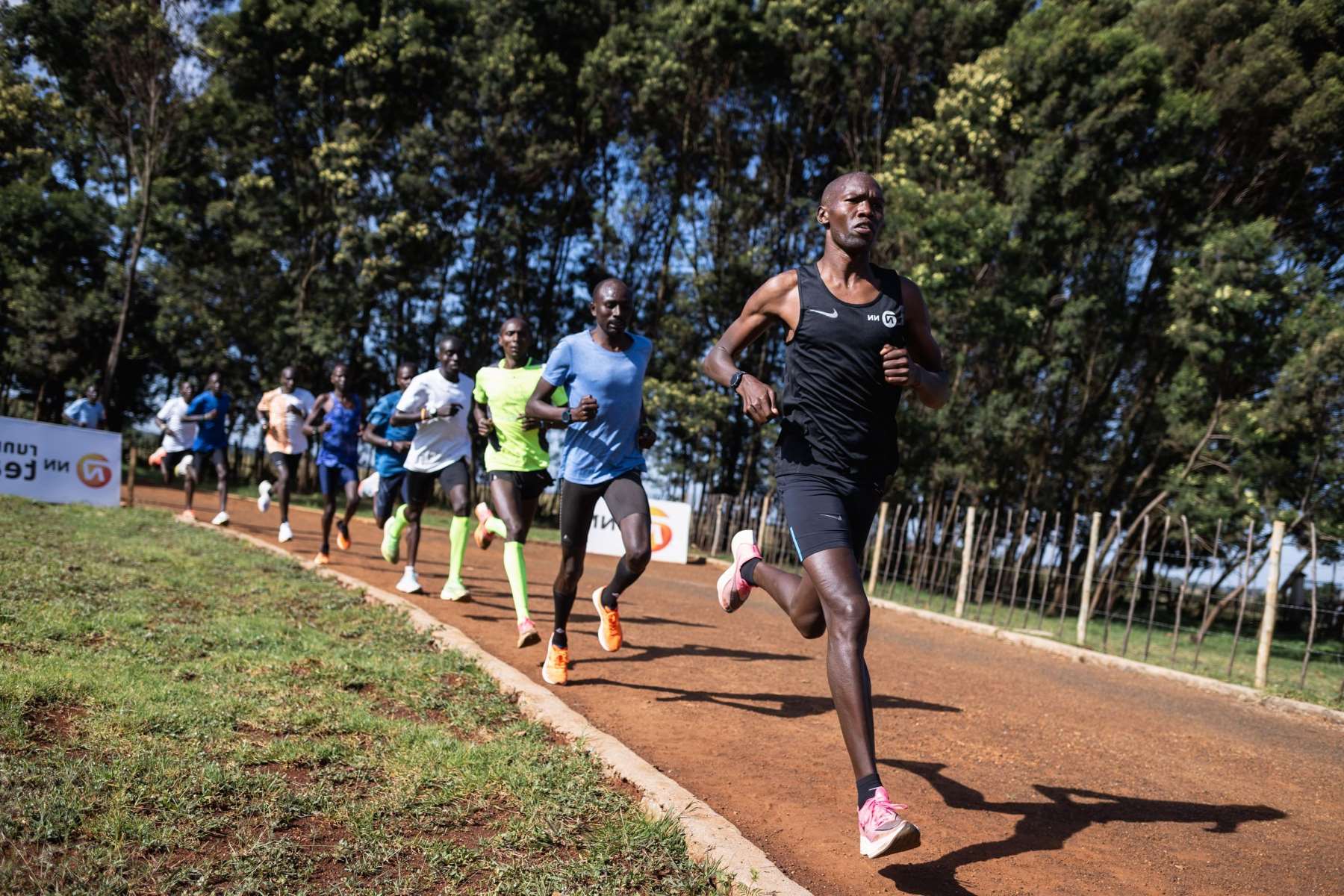Home>Training for Specific Goals>Endurance>10 Long Runs To Improve Your Speed And Endurance


Endurance
10 Long Runs To Improve Your Speed And Endurance
Published: February 20, 2024
Discover 10 long runs to boost your endurance and speed with our expert tips and training plans. Improve your stamina and performance today!
(Many of the links in this article redirect to a specific reviewed product. Your purchase of these products through affiliate links helps to generate commission for Therunningadvisor.com, at no extra cost. Learn more)
Table of Contents
- Benefits of Long Runs for Speed and Endurance
- Tips for Properly Fueling and Hydrating for Long Runs
- The Importance of Rest and Recovery in Long Run Training
- Incorporating Hills and Terrain Variations into Long Runs
- The Role of Mental Toughness in Long Distance Running
- How to Structure Your Long Run Training Schedule
- Cross-Training Activities to Supplement Long Run Training
- Common Mistakes to Avoid in Long Run Training
- Long Run Workouts to Improve Speed and Endurance
- The Impact of Long Runs on Race Day Performance
Benefits of Long Runs for Speed and Endurance
Engaging in long runs offers a myriad of benefits for both speed and endurance, making them an indispensable component of any runner's training regimen. These extended sessions of continuous running, typically covering distances of 10 miles or more, play a pivotal role in enhancing overall performance and fortitude. Here are the key advantages of incorporating long runs into your training routine:
-
Enhanced Cardiovascular Fitness: Long runs stimulate the heart and circulatory system, leading to improved cardiovascular endurance. As you sustain a steady pace over an extended period, your heart becomes more efficient at pumping blood and oxygen to the working muscles, ultimately enhancing your overall endurance capacity.
-
Muscular Adaptation and Endurance: Endurance is not solely about cardiovascular fitness but also about the ability of your muscles to sustain prolonged exertion. Long runs help condition the muscles, tendons, and ligaments to withstand the demands of extended periods of running, thereby reducing the risk of fatigue-related injuries and enhancing overall muscular endurance.
-
Improved Running Economy: Engaging in long runs allows your body to adapt to the biomechanical demands of sustained running, leading to improved running economy. This means that you become more efficient at utilizing oxygen and energy, resulting in better speed and endurance over time.
-
Mental Toughness and Resilience: Long runs provide an ideal platform for mental conditioning. As you push through the physical and mental barriers encountered during extended runs, you cultivate mental toughness and resilience, which are invaluable assets in both speed and endurance events.
-
Fatigue Resistance: By subjecting your body to prolonged running sessions, you train your mind and muscles to resist fatigue. This resistance to fatigue is crucial for maintaining speed and form during the latter stages of a race or a challenging training session.
-
Metabolic Adaptations: Long runs stimulate metabolic adaptations, such as improved fat utilization and glycogen storage, which are essential for sustained energy production during endurance events.
Incorporating long runs into your training routine can significantly contribute to your overall running performance, equipping you with the physical and mental attributes necessary to excel in both speed and endurance events.
Read more: Improve Your 5K Speed With This Workout
Tips for Properly Fueling and Hydrating for Long Runs
Proper fueling and hydration are paramount for optimizing performance and minimizing the risk of fatigue and dehydration during long runs. Implementing effective strategies in these areas can significantly enhance your endurance and speed, allowing you to tackle extended distances with confidence and vigor. Here are essential tips to ensure you are adequately fueled and hydrated for your long runs:
Pre-Run Nutrition
Before embarking on a long run, it's crucial to consume a balanced meal that includes complex carbohydrates, lean proteins, and healthy fats. This provides a steady release of energy and primes your body for the physical demands ahead. Opt for foods such as oatmeal, whole grain toast, or yogurt with fruit to fuel your muscles and sustain energy levels throughout the run.
Hydration Preparation
Hydrating adequately before a long run is vital for maintaining fluid balance and preventing dehydration. Aim to consume around 16-20 ounces of water or a sports drink 2-3 hours before your run. Additionally, consider drinking another 8-10 ounces of fluid 10-20 minutes before starting your run to ensure optimal hydration levels.
During-Run Fueling and Hydration
For runs lasting longer than 60 minutes, it's essential to replenish your body's glycogen stores and maintain hydration. Carry a handheld water bottle or utilize a hydration pack to ensure easy access to fluids throughout the run. Additionally, incorporate energy gels, chews, or sports drinks to provide a quick source of carbohydrates and electrolytes, helping to sustain energy levels and prevent muscle fatigue.
Post-Run Recovery
After completing a long run, prioritize post-run nutrition and hydration to support muscle recovery and replenish depleted energy stores. Consume a combination of carbohydrates and protein within 30 minutes of finishing your run to facilitate muscle repair and glycogen replenishment. Additionally, continue hydrating with water or a sports drink to restore fluid balance and aid in the recovery process.
Tailoring Nutrition and Hydration to Individual Needs
It's important to recognize that optimal fueling and hydration strategies can vary among individuals. Experiment with different foods, drinks, and timing to determine what works best for your body. Pay attention to how your body responds to different fueling and hydration approaches during training runs to refine your strategy for long-distance efforts.
By prioritizing proper fueling and hydration before, during, and after long runs, you can optimize your body's performance, minimize the risk of hitting the wall, and enhance your overall speed and endurance capabilities. These strategies are essential components of successful long-distance running and can make a substantial difference in your training and race day performance.
The Importance of Rest and Recovery in Long Run Training
Rest and recovery are integral components of long run training, playing a pivotal role in optimizing performance, preventing injuries, and promoting overall well-being. While the focus is often placed on the physical exertion of long runs, it is during periods of rest and recovery that the body undergoes crucial adaptations and repairs, ultimately enhancing endurance and speed capabilities.
Physical Repair and Adaptation
Following a long run, the body enters a state of recovery where it repairs damaged muscle fibers, replenishes depleted energy stores, and adapts to the physiological stresses endured during the run. This process is essential for muscle growth, strength development, and the restoration of glycogen levels, all of which contribute to improved endurance and speed.
Injury Prevention
Incorporating adequate rest into a long run training schedule is vital for injury prevention. Overexertion and insufficient recovery can lead to overuse injuries, muscle strains, and fatigue-related issues. By allowing the body time to recuperate, runners can mitigate the risk of chronic injuries and maintain the consistency of their training regimen.
Mental Regeneration
Rest and recovery are not solely physical; they also play a crucial role in mental rejuvenation. Long runs can be mentally taxing, and the inclusion of rest days provides an opportunity for runners to recharge, refocus, and maintain a positive mindset. This mental rejuvenation is essential for sustaining motivation, confidence, and mental resilience throughout the training process.
Performance Optimization
Contrary to common belief, progress in long run training is not solely achieved through continuous exertion. Rest and recovery periods are when the body assimilates the training stimulus, leading to improved performance. By allowing the body to recover, runners can approach subsequent long runs with enhanced vigor, leading to more productive training sessions and improved overall performance.
Balancing Training Stress
A well-structured long run training plan incorporates a balance between training stress and recovery. Overtraining can lead to diminished performance, increased fatigue, and heightened susceptibility to injuries. By strategically integrating rest days and easy recovery runs into the training schedule, runners can optimize their training adaptations and minimize the risk of burnout.
In essence, rest and recovery are indispensable components of long run training, essential for physical repair, injury prevention, mental rejuvenation, performance optimization, and balancing training stress. By recognizing the significance of rest and recovery and integrating them into their training regimen, runners can cultivate resilience, enhance their endurance and speed, and sustain long-term progress in their running pursuits.
Incorporating Hills and Terrain Variations into Long Runs
Incorporating hills and terrain variations into long runs can significantly enhance a runner's speed, endurance, and overall performance. While flat terrain running provides a consistent and steady workout, introducing hills and varied terrain adds a dynamic element to training, offering a host of physical and mental benefits.
Physical Benefits
Running on hilly terrain engages different muscle groups compared to flat surfaces. Uphill running requires greater activation of the quadriceps, calves, and glutes, leading to improved strength and power in these muscle groups. Conversely, downhill running places greater emphasis on eccentric muscle contractions, enhancing muscular endurance and resilience. By regularly incorporating hills into long runs, runners can develop a more robust musculoskeletal system, better preparing them for the demands of race day and improving overall running economy.
Cardiovascular Adaptations
Running uphill elevates heart rate and oxygen consumption, effectively challenging the cardiovascular system. This leads to improved cardiovascular fitness, enhanced stroke volume, and increased oxygen-carrying capacity of the blood. As a result, runners who regularly tackle hills during long runs experience heightened cardiovascular adaptations, translating to improved endurance and speed on both flat and varied terrain.
Mental Toughness and Resilience
Confronting hills and varied terrain during long runs cultivates mental toughness and resilience. The mental fortitude developed through tackling challenging inclines and uneven surfaces can significantly impact a runner's ability to endure discomfort and push through fatigue during races and demanding training sessions. Overcoming the mental hurdles posed by hills fosters a resilient mindset, enabling runners to maintain focus and determination in the face of adversity.
Running Economy and Form
Navigating hills and varied terrain demands adjustments in running form and stride length. This presents an opportunity for runners to refine their biomechanics and running economy. Uphill running encourages a more efficient and powerful stride, while downhill running requires controlled and fluid movement to minimize impact forces. By honing these adjustments during long runs, runners can improve their overall running mechanics, translating to enhanced speed and efficiency across all terrains.
Training Variability
Integrating hills and varied terrain into long runs introduces training variability, preventing monotony and stimulating continuous adaptation. This variability challenges the body in new ways, preventing plateaus and promoting ongoing improvement. Additionally, the diverse stimuli encountered during hill and varied terrain running contribute to a more well-rounded and adaptable athlete, better prepared for the unpredictable nature of race courses and real-world running conditions.
In summary, incorporating hills and varied terrain into long runs offers a multifaceted approach to training, yielding physical, cardiovascular, mental, and biomechanical benefits. By embracing the challenges presented by hills and varied terrain, runners can elevate their performance, fortify their endurance, and develop the resilience necessary to excel in diverse running environments.
The Role of Mental Toughness in Long Distance Running
The significance of mental toughness in long distance running cannot be overstated. While physical conditioning undoubtedly plays a crucial role in a runner's performance, it is the mental fortitude and resilience that often determine the ability to endure the rigors of long distance running. Long runs, especially those covering marathon distances or beyond, present a myriad of mental challenges that can make or break a runner's success.
One of the primary mental hurdles in long distance running is the ability to cope with prolonged discomfort and fatigue. Endurance events test a runner's capacity to push through physical discomfort and mental fatigue, requiring unwavering mental toughness. The ability to maintain focus and determination during extended periods of exertion is a hallmark of mental toughness, enabling runners to persevere when faced with physical and mental adversity.
Moreover, long distance running often involves confronting the psychological barriers of monotony and solitude. Endurance events, particularly during long training runs, can be solitary endeavors, demanding mental resilience to combat feelings of isolation and boredom. Overcoming the mental monotony of running for extended periods requires a resilient mindset and the ability to stay mentally engaged and motivated throughout the run.
In addition to solitude, long distance running also presents the challenge of managing negative thoughts and self-doubt. As the miles accumulate, it is not uncommon for doubts and negative thoughts to surface, testing a runner's mental resolve. Developing the mental toughness to counteract these negative internal dialogues is essential for maintaining confidence and composure during long runs, ultimately influencing performance and endurance.
Furthermore, long distance running often involves navigating unpredictable and adverse conditions, such as inclement weather, challenging terrain, and unforeseen obstacles. The mental resilience to adapt to these variables and remain focused on the task at hand is a hallmark of a mentally tough long distance runner. The ability to embrace adversity and remain composed in the face of unexpected challenges is a testament to the mental strength cultivated through long distance running.
Ultimately, mental toughness in long distance running is not solely about enduring physical discomfort; it encompasses the ability to stay focused, motivated, and resilient in the face of adversity. It is the unwavering mental fortitude that empowers runners to conquer the psychological barriers inherent in long distance running, ultimately shaping their ability to endure, perform, and excel in the most challenging of running endeavors.
How to Structure Your Long Run Training Schedule
Structuring a well-organized and effective long run training schedule is essential for maximizing the benefits of endurance and speed development while minimizing the risk of overtraining and injury. A thoughtfully designed training schedule should encompass a strategic balance of long runs, recovery periods, and supplementary training elements to optimize overall performance and resilience.
Gradual Progression
Initiate your long run training schedule with a focus on gradual progression. Begin with a manageable distance that aligns with your current fitness level and progressively increase the distance by 10-15% each week. This gradual approach allows your body to adapt to the increasing demands of long distance running while minimizing the risk of overuse injuries.
Consistent Long Runs
Incorporate a consistent long run into your weekly schedule, designating a specific day for your extended run. This consistency not only establishes a routine but also allows your body to adapt to the physiological stresses of sustained running, promoting endurance development and mental resilience.
Recovery and Adaptation
Integrate adequate recovery periods between long runs to facilitate physical repair and adaptation. Recovery days or easy runs following a long run provide the necessary rest for muscle repair and glycogen replenishment, ensuring that your body is primed for subsequent training sessions.
Cross-Training and Supplementary Activities
Supplement your long run training with cross-training activities such as cycling, swimming, or strength training. These activities offer a well-rounded approach to fitness, targeting different muscle groups and providing a break from the repetitive impact of running. Additionally, they contribute to overall strength, flexibility, and injury prevention.
Tapering
Incorporate tapering periods into your long run training schedule leading up to key events or races. Tapering involves reducing training volume and intensity in the weeks preceding a race to allow for optimal physical and mental readiness. This strategic reduction in training load ensures that you arrive at race day feeling fresh and prepared to perform at your best.
Flexibility and Adaptation
Maintain flexibility within your training schedule to accommodate unforeseen circumstances, such as illness, fatigue, or unexpected life events. Being adaptable allows you to make necessary adjustments without compromising the overall progression of your long run training.
By structuring your long run training schedule with a focus on gradual progression, consistency, recovery, supplementary activities, tapering, and adaptability, you can optimize your endurance and speed development while minimizing the risk of burnout and injury. This thoughtful approach to training scheduling sets the foundation for sustained progress and peak performance in long distance running endeavors.
Cross-Training Activities to Supplement Long Run Training
Cross-training activities serve as valuable complements to long run training, offering a diverse array of physical and mental benefits that contribute to overall running performance and resilience. By incorporating cross-training into a long run training regimen, runners can enhance their strength, flexibility, and cardiovascular fitness while mitigating the risk of overuse injuries and monotony associated with repetitive running. Here are several cross-training activities that can effectively supplement long run training:
Cycling
Cycling provides an excellent low-impact alternative to running, offering a cardiovascular workout while engaging different muscle groups. The pedaling motion strengthens the quadriceps, hamstrings, and glutes, complementing the muscular demands of running. Additionally, cycling aids in improving leg turnover and cardiovascular endurance, making it an ideal cross-training activity for enhancing overall running performance.
Read more: 5K Run: Boost Your Endurance And Fitness
Swimming
Swimming is a full-body workout that promotes cardiovascular fitness, muscular strength, and flexibility. The low-impact nature of swimming reduces stress on the joints while providing a challenging aerobic workout. Engaging in swimming sessions as part of cross-training can help runners develop upper body strength, improve breathing efficiency, and enhance overall muscular endurance, contributing to a well-rounded fitness profile.
Strength Training
Incorporating strength training exercises, such as weightlifting, bodyweight exercises, and resistance training, is instrumental in fortifying the musculoskeletal system and preventing running-related injuries. Targeting key muscle groups, including the core, hips, and stabilizing muscles, through strength training enhances overall running biomechanics, power, and resilience. Additionally, strength training contributes to improved running economy and injury prevention, making it a valuable component of cross-training for runners.
Yoga and Pilates
Yoga and Pilates focus on flexibility, balance, and core strength, offering runners a holistic approach to physical conditioning. These mind-body practices aid in improving flexibility, enhancing muscular endurance, and promoting mental relaxation and focus. The incorporation of yoga and Pilates into cross-training routines can help runners maintain suppleness, prevent muscle imbalances, and cultivate mental resilience, all of which are essential for long run training and overall running performance.
Flexibility and Mobility Work
Dedicated flexibility and mobility work, including stretching, foam rolling, and mobility exercises, plays a crucial role in injury prevention and recovery. These activities help maintain optimal joint range of motion, alleviate muscle tightness, and promote efficient running mechanics. By integrating flexibility and mobility work into cross-training, runners can address muscular imbalances, reduce the risk of overuse injuries, and optimize their overall physical readiness for long distance running.
Incorporating a combination of these cross-training activities into a long run training schedule offers a comprehensive approach to physical conditioning, injury prevention, and performance enhancement. By diversifying training modalities and engaging in complementary activities, runners can develop a well-rounded fitness foundation, ultimately contributing to improved speed, endurance, and overall running proficiency.
Common Mistakes to Avoid in Long Run Training
Long run training is a multifaceted endeavor that demands careful planning, discipline, and attention to detail. While the pursuit of endurance and speed development through long runs is undoubtedly rewarding, it is essential to be mindful of common pitfalls that can hinder progress and compromise performance. By recognizing and addressing these common mistakes, runners can optimize their training experience and minimize the risk of setbacks. Here are several prevalent mistakes to avoid in long run training:
Rapidly Escalating Mileage
One of the most prevalent errors in long run training is the rapid escalation of mileage without adequate progression. Attempting to cover excessively long distances or dramatically increasing weekly mileage can lead to overuse injuries, burnout, and diminished performance. Gradual progression is key to allowing the body to adapt to the increasing demands of long distance running while minimizing the risk of physical strain.
Neglecting Recovery and Rest
Underestimating the importance of recovery and rest can impede long run training progress. Failing to incorporate adequate rest days, recovery runs, and recovery strategies can lead to overtraining, fatigue, and heightened susceptibility to injuries. Prioritizing recovery and allowing the body time to recuperate is essential for sustaining long-term progress and performance.
Inadequate Fueling and Hydration
Neglecting proper fueling and hydration before, during, and after long runs can compromise performance and hinder endurance development. Inadequate nutrition and hydration strategies can lead to depleted energy stores, diminished endurance capacity, and an increased risk of hitting the wall during long runs. Implementing effective fueling and hydration practices is crucial for sustaining energy levels and optimizing long run performance.
Read more: Improve Your Running With This Hyrox Workout
Ignoring Terrain Variation
Failing to incorporate hills and varied terrain into long run training can limit overall performance and resilience. Running exclusively on flat surfaces neglects the opportunity to develop muscular strength, cardiovascular fitness, and mental toughness required for diverse running conditions. Embracing terrain variation enriches training stimuli and prepares runners for the challenges of real-world race courses.
Lack of Cross-Training
Overreliance on running as the sole form of training neglects the benefits of cross-training activities. Insufficient cross-training can lead to muscular imbalances, reduced flexibility, and an increased risk of overuse injuries. Integrating cross-training activities such as cycling, swimming, and strength training offers a well-rounded approach to physical conditioning and injury prevention.
By avoiding these common mistakes and adopting a balanced, progressive, and holistic approach to long run training, runners can optimize their endurance and speed development while minimizing the risk of setbacks and injuries. Recognizing the significance of strategic planning, recovery, fueling, terrain variation, and cross-training is instrumental in cultivating a resilient and proficient long distance runner.
Long Run Workouts to Improve Speed and Endurance
Long run workouts serve as a cornerstone of training for runners seeking to enhance both speed and endurance. These purposeful sessions are designed to challenge the body's physiological and mental limits, fostering adaptations that translate to improved performance in both short and long distance running events. By incorporating specific long run workouts into their training regimen, runners can target various aspects of their fitness, ultimately elevating their speed and endurance capabilities.
Tempo Runs
Tempo runs, also known as threshold runs, are a fundamental component of long run training aimed at improving speed and lactate threshold. These workouts involve sustaining a comfortably hard pace, typically at or slightly below race pace, for an extended duration. By running at this intensity, runners stimulate physiological adaptations that enhance their ability to sustain higher speeds for longer periods. Tempo runs not only improve cardiovascular fitness and lactate clearance but also cultivate mental toughness, essential for enduring the discomfort associated with sustained high effort.
Read more: Does The Cold Affect Your Running Speed?
Progression Runs
Progression runs are characterized by a gradual increase in pace throughout the duration of the run, culminating in a strong finish at a significantly faster speed. These workouts challenge runners to conserve energy early on and progressively ramp up their effort, simulating the demands of finishing strong in a race. By incorporating progression runs into long run training, runners develop the ability to maintain pace control, improve their finishing kick, and adapt to increasing levels of fatigue, all of which are crucial for race day performance.
Long Intervals
Long interval workouts interspersed within a long run involve alternating periods of higher intensity running with periods of active recovery. These intervals, typically lasting several minutes each, target both aerobic and anaerobic energy systems, promoting improved speed, endurance, and recovery between surges of effort. By incorporating long intervals into long runs, runners enhance their ability to sustain higher speeds, improve oxygen utilization, and develop the mental fortitude required to push through challenging intervals, ultimately translating to enhanced race performance.
Hill Repeats
Incorporating hill repeats within long runs provides a potent stimulus for developing muscular strength, power, and mental resilience. These workouts involve tackling steep inclines at a controlled, effortful pace, followed by a recovery period before repeating the ascent. Hill repeats not only enhance muscular endurance and strength but also improve running economy and mental toughness. By conquering challenging terrain within long runs, runners develop the physical and mental attributes necessary to excel in varied race conditions, ultimately enhancing both speed and endurance.
Fartlek Training
Fartlek, a Swedish term for "speed play," involves unstructured bursts of speed within a long run, interspersed with periods of easy running. This form of interval training allows runners to adapt their pace to the terrain and their perceived effort, simulating the dynamic nature of race conditions. Fartlek training enhances speed, endurance, and mental acuity, as runners learn to respond to varying paces and terrain, ultimately improving their ability to sustain effort and adapt to race day challenges.
By integrating these diverse long run workouts into their training regimen, runners can systematically target speed, endurance, and mental resilience, ultimately enhancing their overall running performance. Each workout serves as a strategic tool for developing specific physiological and mental attributes, contributing to a well-rounded and proficient long distance runner.
Read more: The Secrets Of A Running Expert’s Endurance
The Impact of Long Runs on Race Day Performance
The impact of long runs on race day performance is profound and multifaceted, shaping the physical, mental, and strategic dimensions of a runner's ability to excel in competitive events. Long runs serve as a crucible for the development of endurance, speed, and mental fortitude, ultimately influencing a runner's capacity to perform at their peak on race day.
Physiologically, long runs play a pivotal role in enhancing cardiovascular fitness, muscular endurance, and metabolic adaptations. By subjecting the body to sustained periods of exertion, long runs stimulate physiological adaptations that are essential for enduring the rigors of race day. The cardiovascular system becomes more efficient at delivering oxygen to working muscles, while muscular endurance is bolstered through the conditioning of muscles, tendons, and ligaments. Additionally, long runs stimulate metabolic adaptations, such as improved fat utilization and glycogen storage, crucial for sustained energy production during races.
Mentally, long runs cultivate resilience, focus, and the ability to endure discomfort. Endurance events, such as long runs, provide an ideal platform for mental conditioning, as runners confront the physical and mental challenges inherent in extended periods of exertion. The mental fortitude developed through long runs is instrumental for maintaining composure, confidence, and determination on race day, enabling runners to push through fatigue and adversity.
Strategically, long runs inform race day pacing, fueling strategies, and confidence. By simulating race conditions and distances during long runs, runners gain valuable insights into their pacing capabilities, nutritional needs, and mental resilience. Long runs serve as a testing ground for race day strategies, allowing runners to refine their approach and build confidence in their ability to tackle the demands of the race.
Furthermore, long runs instill a sense of accomplishment, confidence, and readiness for the challenges of race day. The completion of challenging long runs fosters a belief in one's capabilities, providing a psychological edge that translates to race day performance. The mental and emotional benefits derived from conquering long runs contribute to a runner's overall readiness and belief in their capacity to excel in competitive events.
In essence, the impact of long runs on race day performance is far-reaching, influencing physiological adaptations, mental resilience, strategic preparedness, and psychological readiness. Long runs serve as a crucible for the development of the physical and mental attributes necessary for success in endurance events, ultimately shaping a runner's ability to perform at their best on race day.





